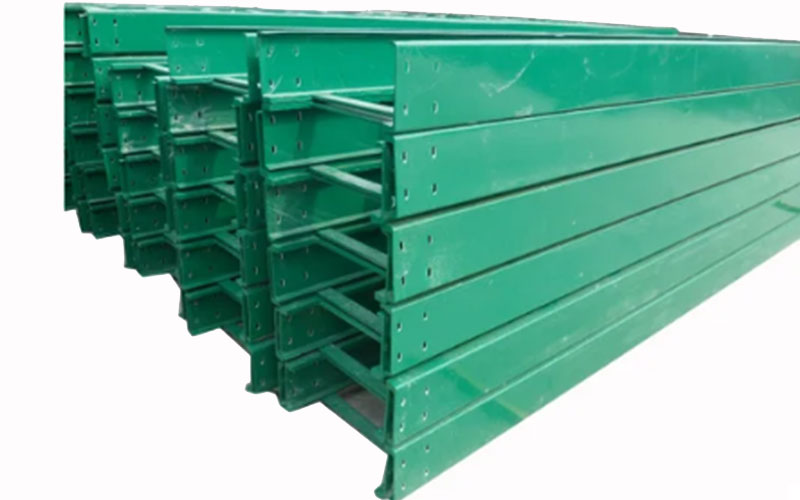
Introduction
India’s industry is undergoing a big change and FRP Cable Trays India is becoming the new norm instead of traditional metal cable management systems. FRP cable trays are being adopted across industries like power generation, telecom, chemical processing and infrastructure development. The reason is a unique combination of durability, safety and cost effectiveness which is in line with India’s push towards sustainable and efficient industrial solutions. This article will explain why this shift is happening, what it means for different industries and long-term impact on Indian industry.
The Power of FRP Cable Trays India
Something’s clicking in India’s factories, power plants, and construction sites. FRP Cable Trays India are becoming the go-to because they tackle real headaches that metal trays can’t touch. These trays, built from a rugged blend of fiberglass and resin, shrug off corrosion, weigh far less than steel, and bring safety perks that make them a must-have in today’s tough industrial world.
Kicking Corrosion to the Curb
India’s got it all salty coastal air, chemical-soaked factories, humid jungles. Steel trays rust away in these conditions, and aluminum doesn’t fare much better, pitting and corroding under chemical attack. That means constant repairs or replacements, which hit budgets hard. FRP trays, though, are a different breed. They stand up to acids, alkalis, and salt like it’s nothing. Ercon Composites, a heavy hitter in the field, has shipped these trays to Oman’s LIWA Plastic Petrochemical Complex, where they’ve held strong in some of the grimmest environments out there.
Light Enough to Lift, Tough Enough to Last
Try hauling a stack of steel trays across a construction site it’s a grind that jacks up labor and shipping costs. Now swap those for FRP trays, which tip the scales at about a third of steel’s weight and a quarter of aluminum’s. Installation becomes a walk in the park, cutting time and money on big projects. Fibrograts, a top Indian manufacturer, says this lightness is a game-changer for builds like railway platforms or bridge frameworks, where every hour saved counts.
Safety That Doesn’t Spark Trouble
In high voltage areas like power plants or telecom hubs one wrong move can be disastrous. Metal trays conduct electricity so they need extra earthing to be safe. FRP trays don’t play that game they’re non-conductive, slashing the risk of shocks or shorts. No earthing needed, which means faster setups and safer operations, especially in industries where downtime is a dirty word.
Built to Beat the Flames
Fires are a nightmare in industrial zones, but FRP trays are ready for the challenge. They meet strict standards like IS 6746 and ASTM-D-635, keeping flames from spreading. That’s a big win for places like refineries or power stations, where safety regulations are ironclad.
Cash Flow and Green Dreams
The move to FRP Cable Trays India isn’t just about better tech it’s about making money work smarter and keeping the environment in mind. As India’s industries stretch to meet growing demands, they need solutions that save now and later while staying kind to the planet.
Money Saved, Year After Year
FRP trays may be a few cents more in initial cost than steel or aluminum, but they're worth it in the long run. They won't rust, weather, or deteriorate under UV radiation, chemicals, or humidity, so there's no requirement for frequent repainting or replacement. Fortune Business Insights estimates the worldwide FRP cable tray market will shoot from USD 253.48 million in 2019 to USD 696.78 million by 2032, with cost-saving industries in India driving that increase.
Greener Ways to Build
Sustainability’s not just a buzzword anymore it’s a dealbreaker. FRP trays, made from recyclable materials and less energy-hungry to produce than steel, fit right into that mindset. Companies like FiberTech are even testing biodegradable resins to make them greener still. This lines up with India’s Smart Cities Mission, which has pumped USD 1.88 billion into eco-friendly urban projects.
Holding Up India’s Big Plans
India’s building like never before smart cities, railway overhauls, renewable energy hubs. FRP trays, light and tough, are a perfect fit for projects like metro lines, tunnels, or bridges. Indian Railways, for instance, uses them for signaling gear and platform setups, keeping things running smoothly across its massive web of tracks.
Where FRP Cable Trays India Stand Out
The real magic of Fiberglass Cable Trays India is how they adapt to different industries, each using their strengths to solve specific problems.

Keeping the Lights On
India’s energy sector thermal plants, solar arrays, wind farms needs cable systems that don’t quit. FRP trays, fire-resistant and able to handle up to 200°F (though they carry less at that heat), are a mainstay in power plants. In Rajasthan’s solar fields, they take on brutal UV and dust, helping India push toward 30% renewable energy by 2025.

Standing Strong in Chemical Plants
Chemical plants and refineries face a daily onslaught of corrosive substances. FRP trays, unbothered by acids or alkalis, are built to last in these rough spots. Aeron Composite says their trays meet NEMA FG-1 standards, making them a rock-solid choice for fertilizer plants and petrochemical setups.

Powering India’s Digital Rise
India’s digital economy is on fire, with telecom networks and data centers at its core. FRP trays, non-conductive and fire-resistant, keep high-speed cables safe, cutting the risk of outages. That’s critical as India aims to be a global digital leader.

Building Tough Foundations
From coastal water treatment plants to urban metro tunnels, FRP trays are changing how infrastructure gets done. Their corrosion resistance and light weight make them easy to install in wet, cramped, or salty spots. India’s USD 142 billion infrastructure push relies on solutions like these.
New Ideas Keeping FRP Ahead
The strength of FRP Cable Trays India comes from constant innovation, with manufacturers tweaking materials and methods to stay on top.
Pultrusion for Rock-Solid Quality
The pultrusion process, used by companies like Ferrotech and Tribeni Fiber, churns out FRP trays with uniform strength and spot-on sizing. This automated system is a lifesaver for big projects that need consistent, reliable trays.
Custom Shapes, Stronger Blends
Mixing fiberglass with carbon fiber creates hybrid trays that can handle heavier loads. Add in 3D printing for custom designs, and you’ve got trays that fit any project’s needs. Cardinal Courier calls these advances a peek into the future.
Tough Against Fire and Sun
Manufacturers like Ercon Composites use resin rich veils to boost UV resistance and fire protection. These upgrades keep trays in line with global standards and are a safe bet for high risk areas.
Modular Designs for Flexibility
Today’s FRP trays come in modular setups, letting industries tweak or scale them as needs shift. This is a big deal for fast-moving fields like data centers or renewable energy.
Building the Future of FRP Cable Trays India
The future of FRP Cable Trays India rests with manufacturers who bring expertise and precision to the table. Based in Rajkot since 2010, FiberTech Composite Pvt. Ltd. has a 75,000 sq ft facility in Gujarat where they manufacture FRP cable trays for chemical plants, coastal setups and power projects. With ISO 9001:2015 certification, they source raw materials from reputed brands like Owens Corning and use pultrusion technology to meet IS 6746 standards. Their trays are corrosion resistant and lighter than metal, serving industries across India and Middle East. This shows how expertise is driving the shift to smart cable management.

Heat Hits Hard
FRP trays lose some strength at high temperatures down to about 52% load capacity at 200°F, per NEMA standards. Manufacturers are working on additives to fix this, but picking the right tray for hot jobs is crucial.

Upfront Costs, Long-Term Payoff
FRP trays can cost more upfront than metal ones, which might spook smaller companies. But in places where corrosion kills metal fast, their durability makes them a steal over time.

Spreading the News
Big industries are all in on FRP, but smaller shops in smaller towns might not know the benefits. Manufacturers need to get the word out to close that gap.

Recycling’s Tough Side
FRP can be recycled, but it’s trickier than metals. Building better recycling systems will keep these trays green as demand grows.

Challenges to Tackle
Even the best tools have their limits, and FRP Cable Trays India are no different.
Case Studies: Real-World Wins
The proof of FRP Cable Trays India is in the projects they’re powering.
Jamnagar Refinery’s Rock-Solid Setup
Reliance Industries’ Jamnagar refinery, the world’s biggest, uses FRP trays to manage cables in a chemical-heavy environment. Their fire resistance and durability keep costs low and operations steady.
Indian Railways’ Fast Track
Indian Railways leans on FRP trays for signaling and platform setups. Their light weight and non-conductive build make installation quick and safe, supporting the railway’s massive overhaul.
Rajasthan’s Solar Push
Rajasthan’s solar plants use FRP trays to handle cables in dusty, UV heavy conditions. Toughness helps the state achieve its 30% renewable energy target by 2025.
Chennai Metro’s Underground Strength
The Chennai Metro relies on FRP trays in its humid, tight tunnels. Their corrosion resistance and easy setup keep cables secure in tough spots.
Gujarat’s Chemical Edge
Gujarat’s chemical industry, a powerhouse in India, uses FRP trays in fertilizer and petrochemical plants. Their resistance to harsh substances means less downtime and lower costs.
The Road Ahead for FRP Cable Trays India
The future’s looking up for FRP Cable Trays India, with growth, innovation, and big plans driving them forward.
A Market Ready to Boom
The global FRP cable tray market is set to grow at a CAGR of 8.36% from 2024 to 2032, with India leading the Asia-Pacific toward USD 696.78 million. Infrastructure and manufacturing strength are the fuel.
Wiring Smart Cities
India’s Smart Cities Mission and digital push need reliable wiring, and FRP trays deliver. Their non-conductive durability makes them perfect for smart grids and IoT setups.
Going Global
Indian manufacturers like Runaya and Ercon Composites are shipping FRP trays to places like Saudi Arabia and Oman. Techniques like UV-cured resins keep them competitive worldwide.
Staying Green
Sustainability will keep FRP trays in demand. Biodegradable resins and better recycling will align them with global eco-goals, cementing India’s role in green industry.
Training Up
To get the most out of FRP trays, industries need skilled workers. Partnerships with technical schools can ensure smooth adoption.
Matching Global Standards
As Indian manufacturers meet standards like NEMA and ASTM, FRP trays will win over more global markets, making India a leader in cable management.
Conclusion
The rise of FRP Cable Trays India is big towards smarter, tougher, greener ways to manage cables. They beat corrosion, save money and keep safety first, proving their worth in refineries, railways and beyond. As India builds smart cities, digital networks and clean energy systems, these trays are at the core of it. With a growing market and bold innovations, FRP cable tray exporters are setting the stage for a future where efficiency and sustainability go hand in hand.
Recent Post
Why FRP Pultruded Gratings are Transforming Industrial Flooring Solutions
Why FRP Moulded Gratings Are Transforming Chemical and Utility Infrastructure
Why Indian Industries Are Making the Shift to FRP Cable Trays and What It Means for the Future
Why FRP Pultruded Gratings Are Spearheading India's Anti Corrosion Revolution
